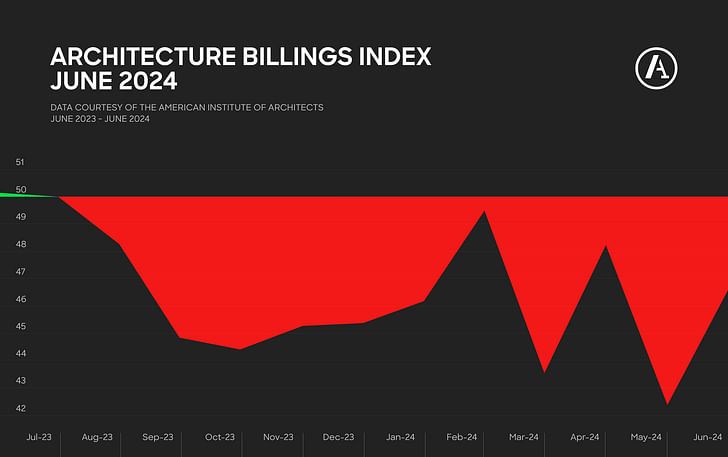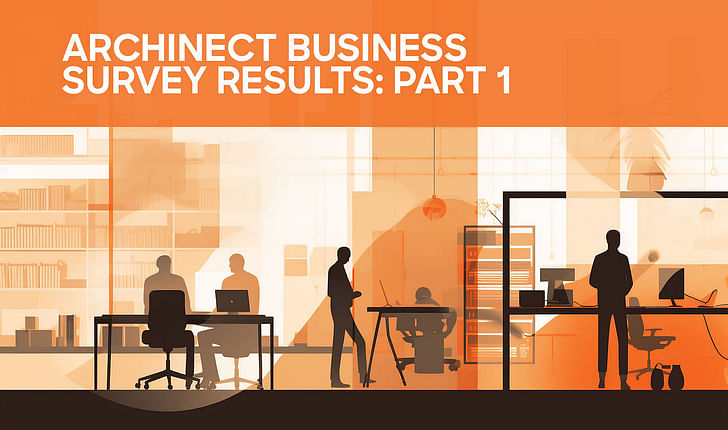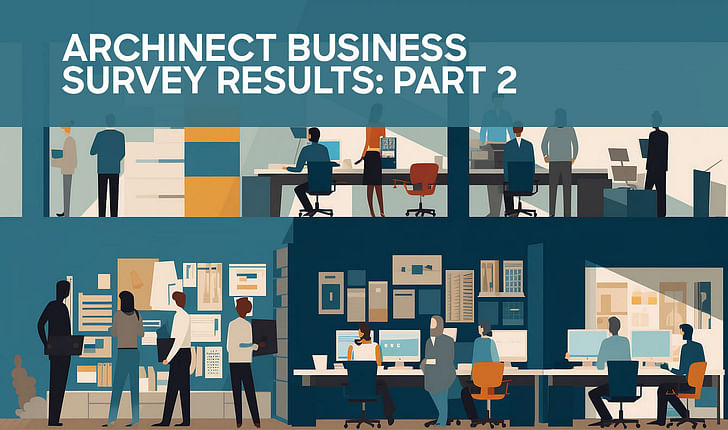

Welcome to the second installment of Archinect's new series, State of AEC. At the end of each month, we will guide you through the latest analyses, indexes, and trends on how the architecture and construction industries are performing economically.
As we reflect back on June and July 2024, we see continued declines in billings among architecture firms, in addition to a decrease in new on-site construction activity. Commentators on the business health of the industry are almost unanimous in voicing hopes that interest rate cuts, rumored to be announced by the Federal Reserve next month, may propel growth in design studios and construction sites alike.
Read our full roundup of the month's economic and business figures below, and find out more about how the business health of the architecture profession is faring via our recently-released survey results here.
Design and Planning
The latest AIA/Deltek Architecture Billings Index (ABI), covering June, found that billings are continuing to decline at a majority of firms, though not as significantly as the month before. The index score of 46.4 indicates that slightly more firms reported a decline in billings in the previous month than reported an increase. While billings declined, firms are continuing to see an increase in new inquiries, as they have done for the past year. The dollar value of new contracts signed has decreased, however, with marginally more architecture firms saying that contract values declined last month.
“While many firms still have a healthy backlog of projects in the pipeline, 6.4 months on average, this is the smallest that backlogs have been in more than three years,” the AIA said about their latest findings. “Despite this ongoing softness, firms remain generally optimistic that conditions will start to improve once interest rates begin to decline but are likely to continue experiencing challenges at least until then.”
Stock market turmoil in recent days has led to further speculation in the national press that the Federal Reserve may cut interest rates next month. CNBC has reported that traders have priced in a half-point cut in September, with further cuts leading to interest rates sitting 2.25 points lower by the end of next year than they are now.

Elsewhere, June's Dodge Momentum Index, which measures the value of nonresidential building projects going into planning, saw a 10.4% increase on the previous month. The index now sits at one of its highest figures in recent years and disrupts a general trend of nonresidential planning decline throughout 2024.
“Data centers continued to dominate planning projects in June — fueling another strong month for commercial planning,” said Sarah Martin, Associate Director of Forecasting at Dodge Construction Network. “More momentum in planning, while not as strong as data centers, was seen across most segments and indicates confidence in 2025 market conditions. The DMI is up 43% from June 2019 levels, signaling strong construction spending in 2025.”

Construction
Overall, total construction starts across the United States fell 19% last month, according to Dodge Construction Network. Compared to last year, total construction starts are 7% higher than they were for the first six months of 2023.
“The construction market remains sluggish as high interest rates continue to reverberate through the sector,” said Richard Branch, chief economist of Dodge Construction Network. “However, the Dodge Momentum Index, which tracks nonresidential building projects entering the planning phase, has been reasonably steady over the last year indicating that owners and developers remain cautiously optimistic that the conditions will be more conducive to construction in the future.”
“But moribund starts activity means that these projects are piling up like water behind a dam,” Branch added. “Lower rates in 2024 will allow these projects to start flowing again, resulting in a quicker pace of activity towards year-end.”
While construction activity declined last month, so did the cost of producing materials for construction. Data from the U.S. Bureau of Labor Statistics showed that construction input prices decreased 0.3%, with the cost of softwood lumber production falling by 0.5% while the cost of concrete products production increased by 0.4%.
“Construction materials prices dipped in June, perhaps a reflection of declining project starts in a number of construction segments and an associated dip in demand,” said ABC Chief Economist Anirban Basu about the figures. Basu went on to warn that while contractors see stable backlogs of work and material production prices are falling, inflation remains a concern in the industry. Like other commentators throughout the month, Basu warned of the impacts of high interest rates on the sector’s prospects.

Elsewhere, project delays, pauses, and abandonments in the non-residential sector are increasing. ConstructConnect’s latest Project Stress Index saw a 1.5% increase in its June metric compared to May, with disruption 9% up on June 2023.
In tandem with these delays, pauses, and abandonments, nonresidential construction spending also dipped 0.2% nationwide in June, according to ABC analysis of U.S. Census Bureau data. Spending is nonetheless 5.3% higher than one year ago.
“A new trend in nonresidential construction is emerging, and it’s not a good thing,” ABC’s Basu noted about the figures. “Despite a bevy of megaprojects in certain parts of the nation, overall nonresidential construction spending appears to have entered a period of stagnation.”
The construction market remains sluggish as high interest rates continue to reverberate through the sector. — Richard Branch, Dodge Construction Network
Northeast
Architecture firms in the Northeast told the AIA ABI that business conditions are improving, with June being the first month in almost a year that firms reported an increase in billings.
Total construction starts in the Northeast increased last month, according to Dodge Construction Network, while U.S. Census data shows that residential permits granted increased marginally by 1% on last month. However, New York City’s new apartment construction has hit a historic low, as we reported last month.
Midwest
According to the ABI, business conditions in architecture firms in the Midwest are in decline, with the rate of decline in the region being the fastest over the past year. Of the four U.S. regions, the Midwest reported the fastest rate of decline in business conditions for the past three months in a row.
Total construction starts in the Midwest also decreased last month, according to Dodge Construction Network, while U.S. Census data shows that residential permits granted remained steady on the previous month.
West
Firms in the West region have seen a continuing decline in business conditions in the ABI, though the decline rate has been stable since last month. The West continues to see the longest duration of decline of any region, at 21 consecutive months.
Total construction starts in the West declined last month, according to Dodge Construction Network, while U.S. Census data shows that residential permits granted declined by 5% on last month.
South
Firms in the South region have continued a 12-month trend of reporting that business conditions have worsened in the previous month according to the ABI, with the rate of decline accelerating.
Total construction starts in the South decreased last month, according to Dodge Construction Network, while U.S. Census data shows that residential permits granted fell significantly by 8.2% last month.

Residential
According to the ABI, firms specializing in multifamily residential projects have continued to see a decline in billings. Such firms have not reported an increase in billings from the previous month since August 2022.
On the construction side, the number of residential starts rose by 9%, according to Dodge Construction Network. On a year-to-year basis, residential starts are up 14% from the first six months of 2023. Total residential spending is also 7.3% higher than it was one year ago, though falling by a marginal 0.4% over the last month.
Digging deeper into the residential sector, single-family starts rose 4%, according to Dodge, while multifamily starts soared by 23%. Over the past twelve months, single-family starts have risen 25% versus the previous twelve-month period, although multifamily starts were 6% lower.
In the national media, meanwhile, Moody’s warned that an interest rate cut would not fix the U.S. housing crisis, arguing that a subsequent dip in mortgage rates would not be sufficient to combat high median existing home prices.
Commercial/Industrial
Firms specializing in major non-residential sectors have reported a significant decline in billings on the previous month. According to the ABI, firms specializing in commercial/industrial projects continue to see a deterioration in billings, and last month experienced the fastest decline in 12 months. The last time such firms reported an increase in billings on the previous month was July 2023.
Despite a decline in billings for commercial projects, the value of commercial projects currently in planning has risen by 14.5% on last month, according to the Dodge Momentum Index, with the value of such projects up 25% on this time last year.
“Data center planning continued to be the primary driver of commercial growth in June, alongside moderate growth in retail, hotels, and warehouse projects,” Dodge noted, continuing the trend from our previous report of an increase in demand for new data center projects propelling the commercial planning statistics.
In construction, commercial starts are up 4% on last month, attributed by Dodge Construction Network to data center activity. Meanwhile, industrial project starts declined 34% on May. For the 12 months ending in June 2024, commercial starts are down 9% more than the previous 12 months, with industrial starts being down 33%.
Institutional/Cultural
Firms specializing in institutional projects continue to report a decline in billings, according to the ABI, with the rate of decline stabilizing over the last three months. Such firms have reported a decline in billings almost every month since July 2023, with the sole exception of January 2024, where billings were stagnant on the previous month.
In addition to a decline in billings, there has been a decline in the value of institutional projects currently being planned. The Dodge Momentum Index reports that the value of planned institutional projects has increased 0.2%, while the value of such projects is down 25% on this time last year.
In construction, institutional starts declined 19% in June, according to Dodge Construction Network, while for the 12 months ending in June 2024, institutional starts are up 8% from the previous 12 months.
Meanwhile, Archinect recently reported that the value of completed cultural projects from 2023 is more than $8 billion. The authors of the study, AEA Consulting, nonetheless warned that while the volume of new cultural projects has increased, the value of investment is decreasing. The Institutional sector is however projected to see a more than 10% gain this year before slowing to 4% in 2025, according to new data from the AIA.

“Given that we do a lot of federal work, the fact that it is an election year is causing us pain,” a large firm in the South specializing in institutional projects told the AIA via their Work on the Boards survey. “This, coupled with the fact that there is not a budget signed for the year, is causing an uncertainty in work.” Meanwhile, a 60-person firm from the Northeast specializing in residential projects told the AIA that the multifamily market “continues to be strong, despite all the obvious headwinds.”
“Many owners/developers are simply waiting for interest rates to finally come down,” an architect from a small firm in Oakland, CA, told Archinect in our recent business survey, while another from a medium-sized firm in New York City noted that: “High interest rates have taken the bottom out of residential lending, both for new mortgages and construction loans.”
Share your own experiences of the AEC sector in the comments section below. When doing so, please tell us which U.S. Census region you are based in (Northeast/Midwest/West/South) and the size of your firm.
Finally, Archinect recently revealed the results and analysis of our survey on business conditions in the architecture industry. The results can be found here, while our analysis of the five factors behind the conditions can be found here.
Niall Patrick Walsh is an architect and journalist, living in Belfast, Ireland. He writes feature articles for Archinect and leads the Archinect In-Depth series. He is also a licensed architect in the UK and Ireland, having previously worked at BDP, one of the largest design + ...
1 Comment
According to reliable indicators, the interest rates won't come down or come down significantly in the next few years. Hardly ever to 3% levels which propped up the construction and architectural employment. I don't think the material price cuts are significant as the labor prices continuously increase in greater percentages.
What a sad point for the building industry to mainly rely upon the interest rates. Markets and industries must invent and employ more creative, no-frills, cost-cutting ways to finance construction.
Who knows? That might even push the building designs to seek more inventive building methods and systems. However, that might cause different physical and cultural changes in the cities and suburbs. Have you ever visited small, non-touristic European towns and villages in industrial and agricultural regions? They have already left the house as "a man's castle" for multi-unit apartment living. That is a significant culturally different mindset.
Block this user
Are you sure you want to block this user and hide all related comments throughout the site?
Archinect
This is your first comment on Archinect. Your comment will be visible once approved.